Ola Cabs: Evaluating Australian Market for International Growth
VerifiedAdded on 2023/06/09
|12
|2662
|367
Report
AI Summary
This report assesses the potential of the Australian market for Ola Cabs, examining the company's background, strengths, and weaknesses in the context of international expansion. It delves into the Australian market's macro environment using PESTLE analysis, covering political, economic, social, technological, legal, and environmental factors. The report also analyzes market competitiveness, including the bargaining power of buyers and suppliers, the threat of substitutes and new entrants, and competitive rivalry. Key opportunities and challenges are identified, such as the favorable economic environment and the presence of established competitors. The report concludes with recommendations for Ola Cabs to enhance their business potential in the Australian market, including diversifying service offerings and adopting a geocentric management approach. Desklib provides this assignment solution along with a wealth of study resources for students.
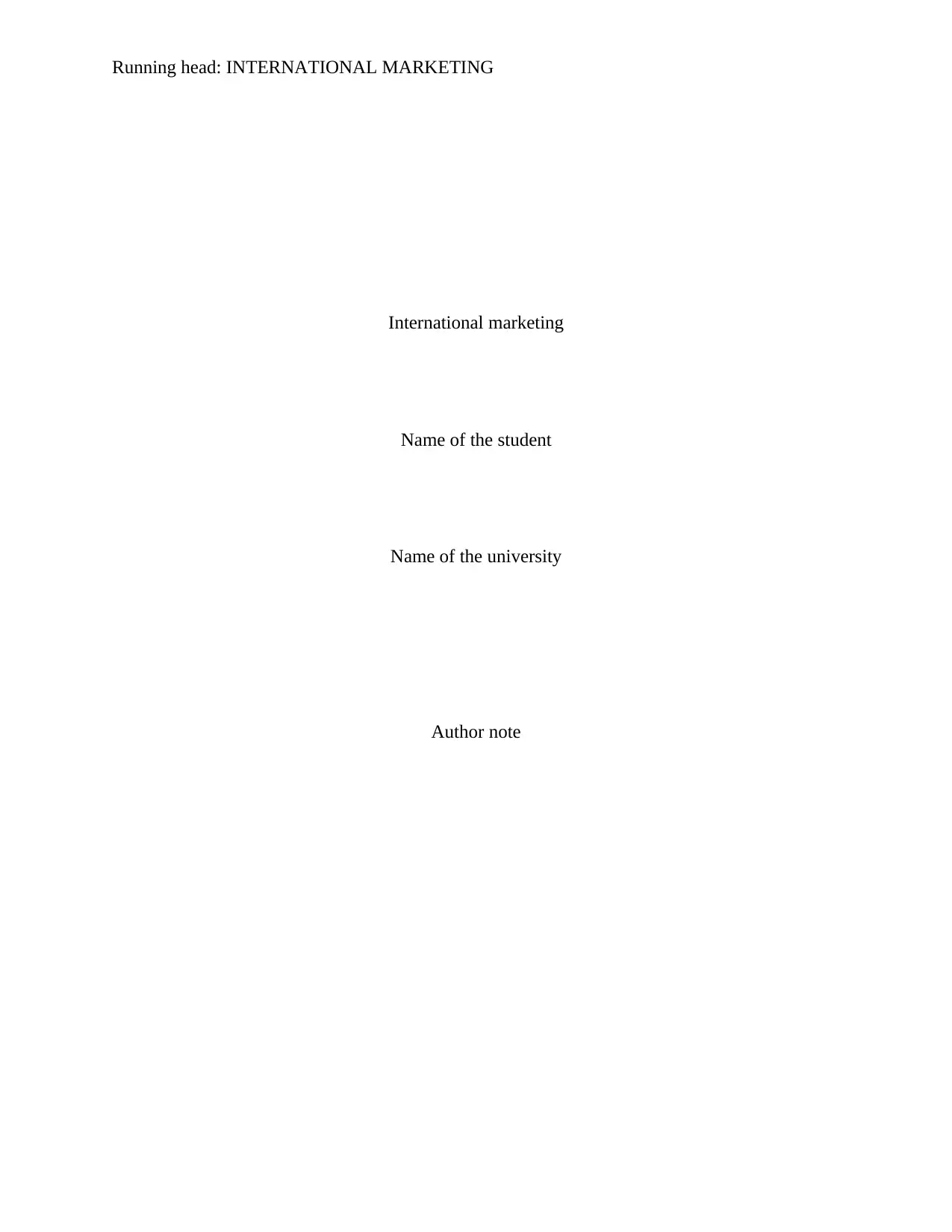
Running head: INTERNATIONAL MARKETING
International marketing
Name of the student
Name of the university
Author note
International marketing
Name of the student
Name of the university
Author note
Paraphrase This Document
Need a fresh take? Get an instant paraphrase of this document with our AI Paraphraser
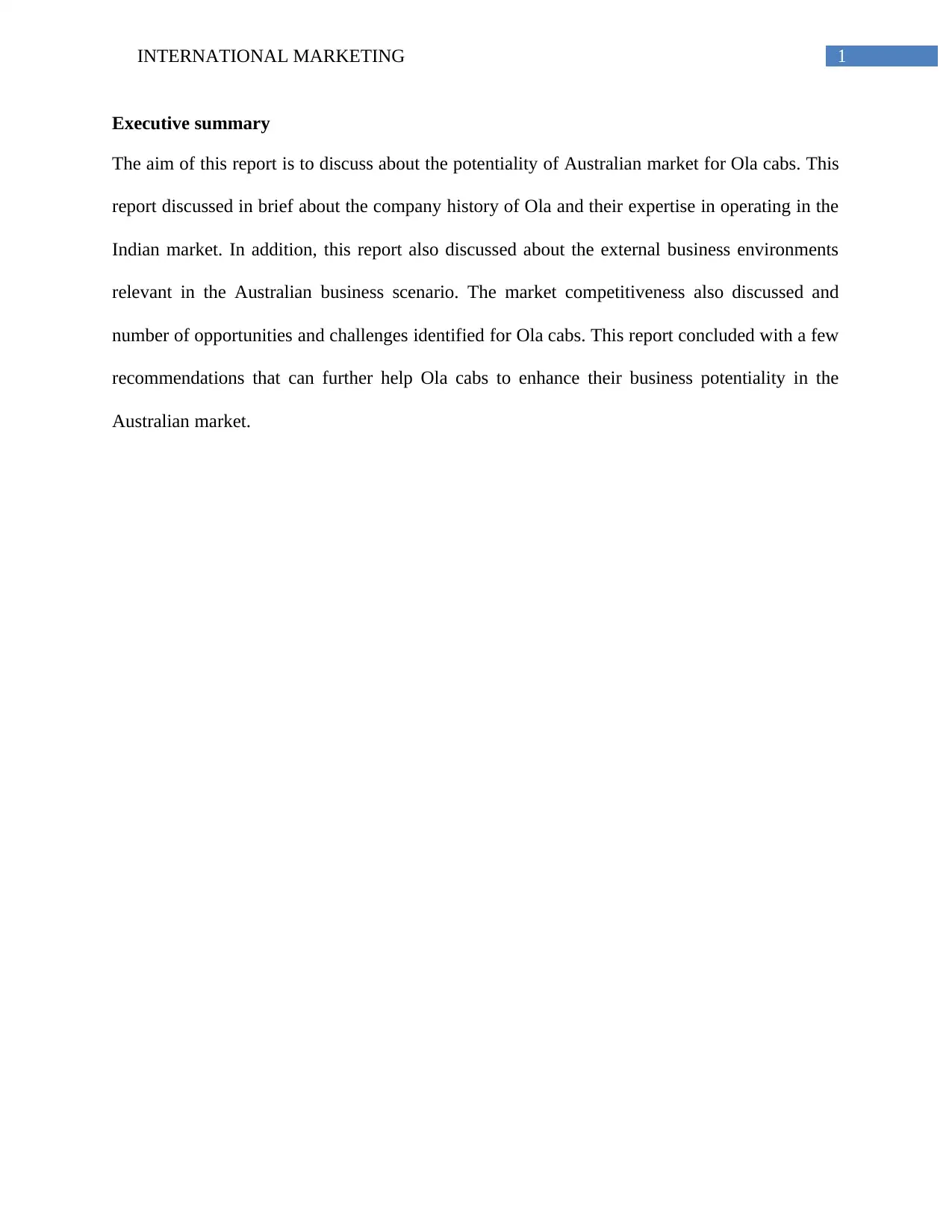
1INTERNATIONAL MARKETING
Executive summary
The aim of this report is to discuss about the potentiality of Australian market for Ola cabs. This
report discussed in brief about the company history of Ola and their expertise in operating in the
Indian market. In addition, this report also discussed about the external business environments
relevant in the Australian business scenario. The market competitiveness also discussed and
number of opportunities and challenges identified for Ola cabs. This report concluded with a few
recommendations that can further help Ola cabs to enhance their business potentiality in the
Australian market.
Executive summary
The aim of this report is to discuss about the potentiality of Australian market for Ola cabs. This
report discussed in brief about the company history of Ola and their expertise in operating in the
Indian market. In addition, this report also discussed about the external business environments
relevant in the Australian business scenario. The market competitiveness also discussed and
number of opportunities and challenges identified for Ola cabs. This report concluded with a few
recommendations that can further help Ola cabs to enhance their business potentiality in the
Australian market.
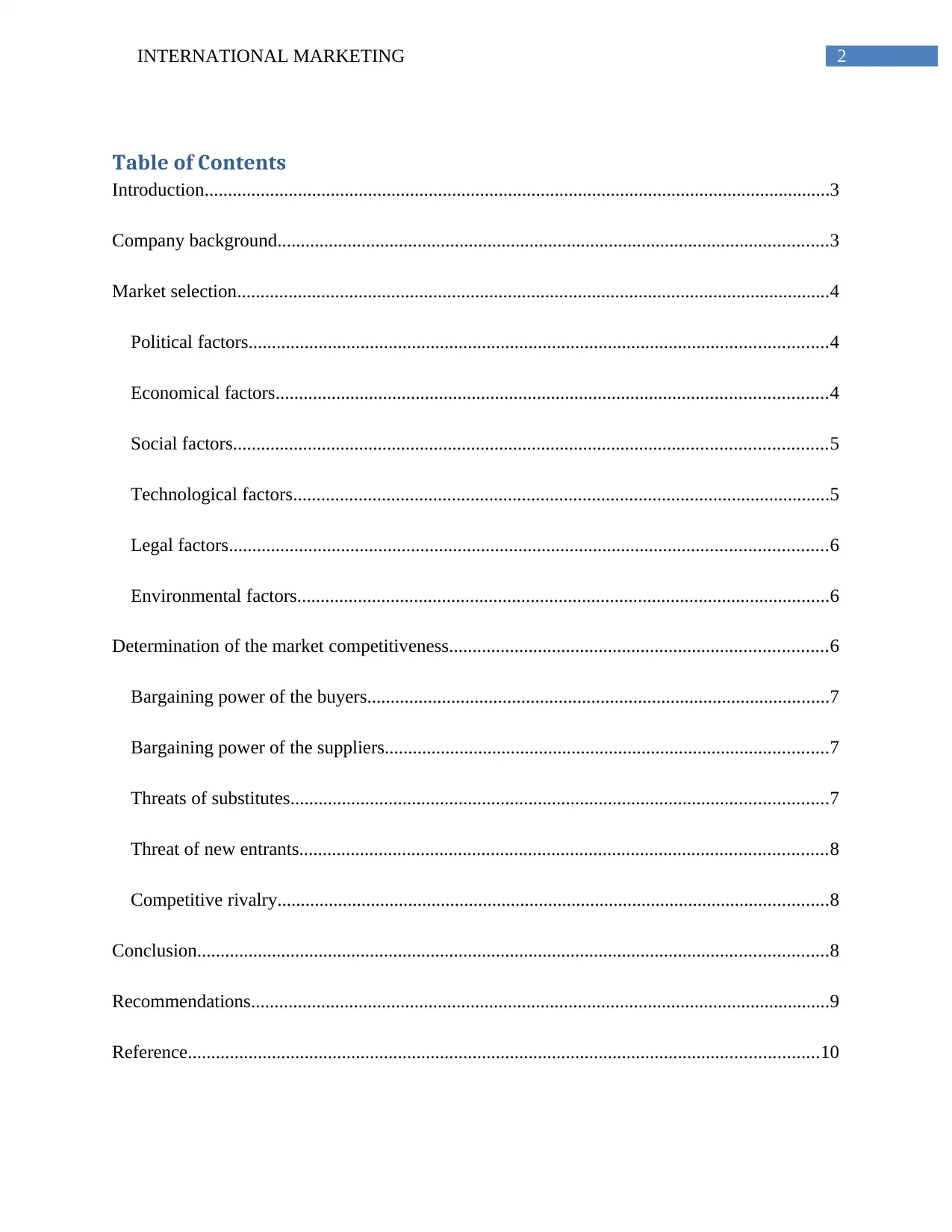
2INTERNATIONAL MARKETING
Table of Contents
Introduction......................................................................................................................................3
Company background......................................................................................................................3
Market selection...............................................................................................................................4
Political factors............................................................................................................................4
Economical factors......................................................................................................................4
Social factors...............................................................................................................................5
Technological factors...................................................................................................................5
Legal factors................................................................................................................................6
Environmental factors..................................................................................................................6
Determination of the market competitiveness.................................................................................6
Bargaining power of the buyers...................................................................................................7
Bargaining power of the suppliers...............................................................................................7
Threats of substitutes...................................................................................................................7
Threat of new entrants.................................................................................................................8
Competitive rivalry......................................................................................................................8
Conclusion.......................................................................................................................................8
Recommendations............................................................................................................................9
Reference.......................................................................................................................................10
Table of Contents
Introduction......................................................................................................................................3
Company background......................................................................................................................3
Market selection...............................................................................................................................4
Political factors............................................................................................................................4
Economical factors......................................................................................................................4
Social factors...............................................................................................................................5
Technological factors...................................................................................................................5
Legal factors................................................................................................................................6
Environmental factors..................................................................................................................6
Determination of the market competitiveness.................................................................................6
Bargaining power of the buyers...................................................................................................7
Bargaining power of the suppliers...............................................................................................7
Threats of substitutes...................................................................................................................7
Threat of new entrants.................................................................................................................8
Competitive rivalry......................................................................................................................8
Conclusion.......................................................................................................................................8
Recommendations............................................................................................................................9
Reference.......................................................................................................................................10
⊘ This is a preview!⊘
Do you want full access?
Subscribe today to unlock all pages.

Trusted by 1+ million students worldwide
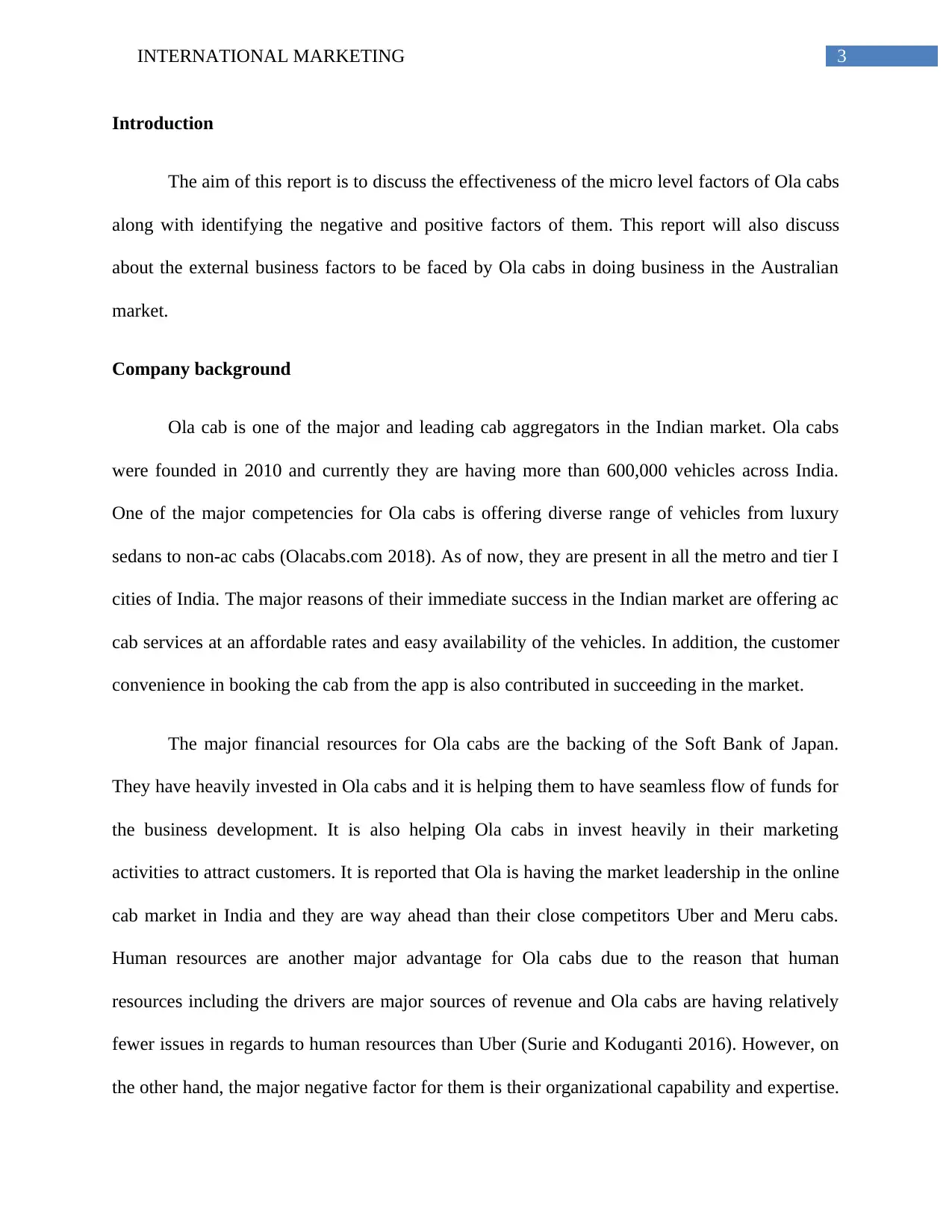
3INTERNATIONAL MARKETING
Introduction
The aim of this report is to discuss the effectiveness of the micro level factors of Ola cabs
along with identifying the negative and positive factors of them. This report will also discuss
about the external business factors to be faced by Ola cabs in doing business in the Australian
market.
Company background
Ola cab is one of the major and leading cab aggregators in the Indian market. Ola cabs
were founded in 2010 and currently they are having more than 600,000 vehicles across India.
One of the major competencies for Ola cabs is offering diverse range of vehicles from luxury
sedans to non-ac cabs (Olacabs.com 2018). As of now, they are present in all the metro and tier I
cities of India. The major reasons of their immediate success in the Indian market are offering ac
cab services at an affordable rates and easy availability of the vehicles. In addition, the customer
convenience in booking the cab from the app is also contributed in succeeding in the market.
The major financial resources for Ola cabs are the backing of the Soft Bank of Japan.
They have heavily invested in Ola cabs and it is helping them to have seamless flow of funds for
the business development. It is also helping Ola cabs in invest heavily in their marketing
activities to attract customers. It is reported that Ola is having the market leadership in the online
cab market in India and they are way ahead than their close competitors Uber and Meru cabs.
Human resources are another major advantage for Ola cabs due to the reason that human
resources including the drivers are major sources of revenue and Ola cabs are having relatively
fewer issues in regards to human resources than Uber (Surie and Koduganti 2016). However, on
the other hand, the major negative factor for them is their organizational capability and expertise.
Introduction
The aim of this report is to discuss the effectiveness of the micro level factors of Ola cabs
along with identifying the negative and positive factors of them. This report will also discuss
about the external business factors to be faced by Ola cabs in doing business in the Australian
market.
Company background
Ola cab is one of the major and leading cab aggregators in the Indian market. Ola cabs
were founded in 2010 and currently they are having more than 600,000 vehicles across India.
One of the major competencies for Ola cabs is offering diverse range of vehicles from luxury
sedans to non-ac cabs (Olacabs.com 2018). As of now, they are present in all the metro and tier I
cities of India. The major reasons of their immediate success in the Indian market are offering ac
cab services at an affordable rates and easy availability of the vehicles. In addition, the customer
convenience in booking the cab from the app is also contributed in succeeding in the market.
The major financial resources for Ola cabs are the backing of the Soft Bank of Japan.
They have heavily invested in Ola cabs and it is helping them to have seamless flow of funds for
the business development. It is also helping Ola cabs in invest heavily in their marketing
activities to attract customers. It is reported that Ola is having the market leadership in the online
cab market in India and they are way ahead than their close competitors Uber and Meru cabs.
Human resources are another major advantage for Ola cabs due to the reason that human
resources including the drivers are major sources of revenue and Ola cabs are having relatively
fewer issues in regards to human resources than Uber (Surie and Koduganti 2016). However, on
the other hand, the major negative factor for them is their organizational capability and expertise.
Paraphrase This Document
Need a fresh take? Get an instant paraphrase of this document with our AI Paraphraser
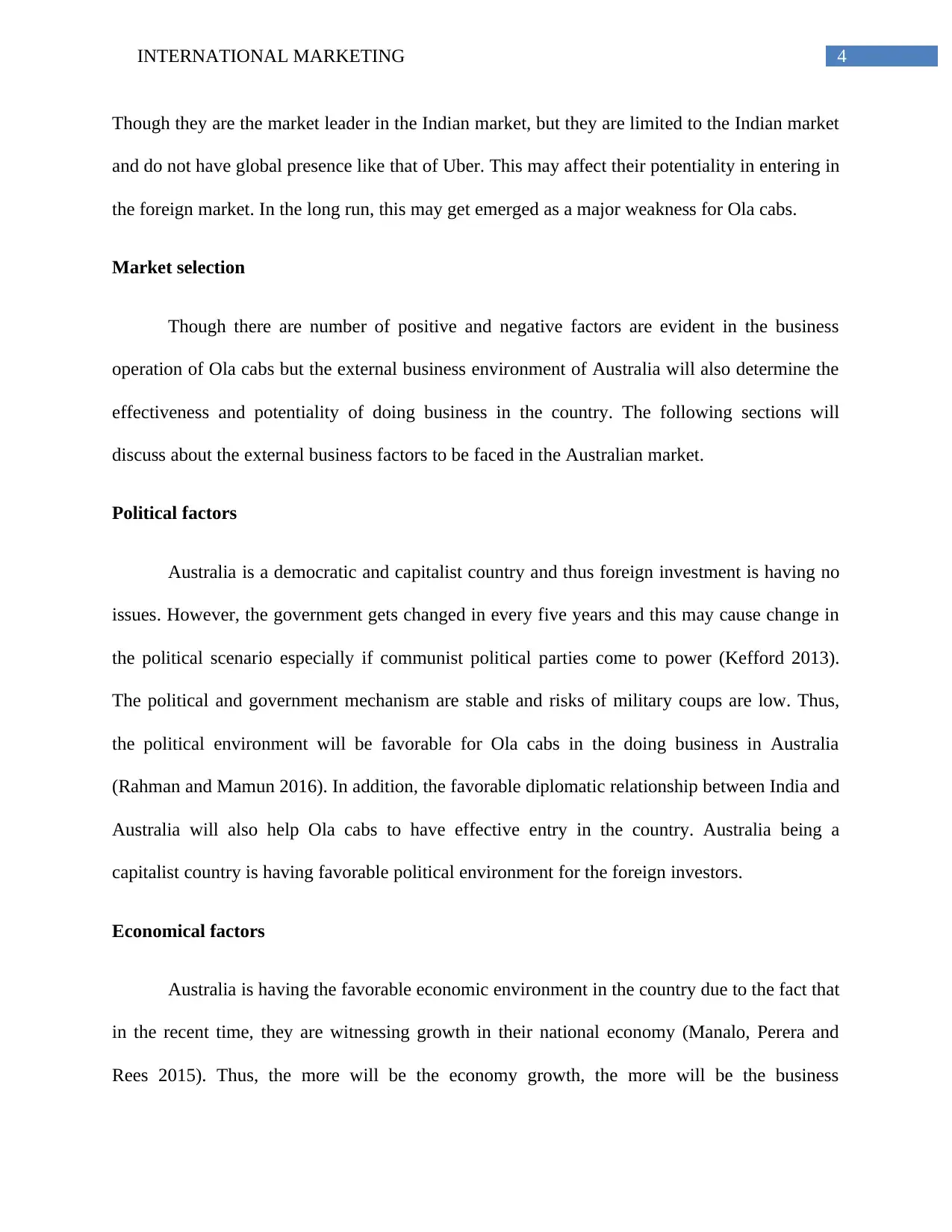
4INTERNATIONAL MARKETING
Though they are the market leader in the Indian market, but they are limited to the Indian market
and do not have global presence like that of Uber. This may affect their potentiality in entering in
the foreign market. In the long run, this may get emerged as a major weakness for Ola cabs.
Market selection
Though there are number of positive and negative factors are evident in the business
operation of Ola cabs but the external business environment of Australia will also determine the
effectiveness and potentiality of doing business in the country. The following sections will
discuss about the external business factors to be faced in the Australian market.
Political factors
Australia is a democratic and capitalist country and thus foreign investment is having no
issues. However, the government gets changed in every five years and this may cause change in
the political scenario especially if communist political parties come to power (Kefford 2013).
The political and government mechanism are stable and risks of military coups are low. Thus,
the political environment will be favorable for Ola cabs in the doing business in Australia
(Rahman and Mamun 2016). In addition, the favorable diplomatic relationship between India and
Australia will also help Ola cabs to have effective entry in the country. Australia being a
capitalist country is having favorable political environment for the foreign investors.
Economical factors
Australia is having the favorable economic environment in the country due to the fact that
in the recent time, they are witnessing growth in their national economy (Manalo, Perera and
Rees 2015). Thus, the more will be the economy growth, the more will be the business
Though they are the market leader in the Indian market, but they are limited to the Indian market
and do not have global presence like that of Uber. This may affect their potentiality in entering in
the foreign market. In the long run, this may get emerged as a major weakness for Ola cabs.
Market selection
Though there are number of positive and negative factors are evident in the business
operation of Ola cabs but the external business environment of Australia will also determine the
effectiveness and potentiality of doing business in the country. The following sections will
discuss about the external business factors to be faced in the Australian market.
Political factors
Australia is a democratic and capitalist country and thus foreign investment is having no
issues. However, the government gets changed in every five years and this may cause change in
the political scenario especially if communist political parties come to power (Kefford 2013).
The political and government mechanism are stable and risks of military coups are low. Thus,
the political environment will be favorable for Ola cabs in the doing business in Australia
(Rahman and Mamun 2016). In addition, the favorable diplomatic relationship between India and
Australia will also help Ola cabs to have effective entry in the country. Australia being a
capitalist country is having favorable political environment for the foreign investors.
Economical factors
Australia is having the favorable economic environment in the country due to the fact that
in the recent time, they are witnessing growth in their national economy (Manalo, Perera and
Rees 2015). Thus, the more will be the economy growth, the more will be the business
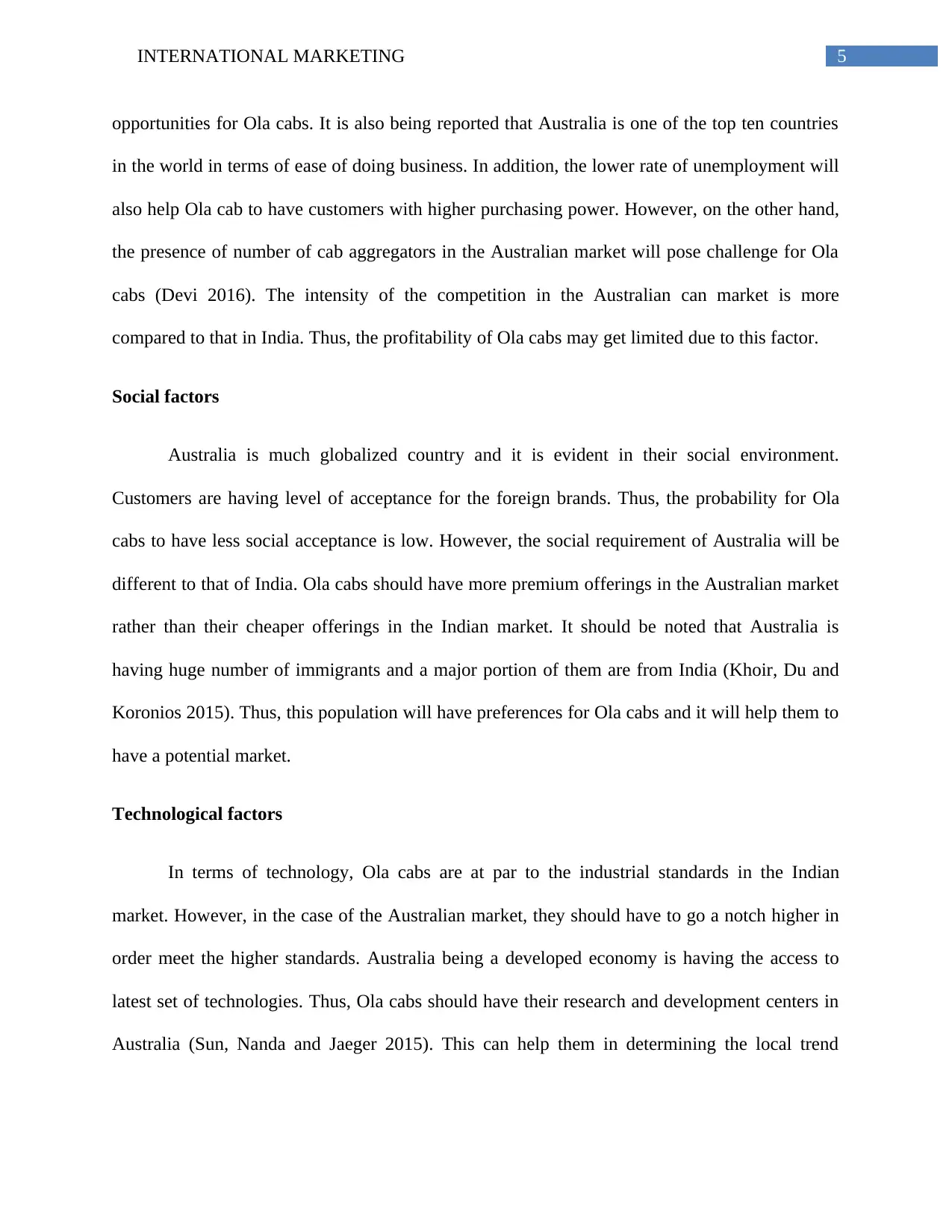
5INTERNATIONAL MARKETING
opportunities for Ola cabs. It is also being reported that Australia is one of the top ten countries
in the world in terms of ease of doing business. In addition, the lower rate of unemployment will
also help Ola cab to have customers with higher purchasing power. However, on the other hand,
the presence of number of cab aggregators in the Australian market will pose challenge for Ola
cabs (Devi 2016). The intensity of the competition in the Australian can market is more
compared to that in India. Thus, the profitability of Ola cabs may get limited due to this factor.
Social factors
Australia is much globalized country and it is evident in their social environment.
Customers are having level of acceptance for the foreign brands. Thus, the probability for Ola
cabs to have less social acceptance is low. However, the social requirement of Australia will be
different to that of India. Ola cabs should have more premium offerings in the Australian market
rather than their cheaper offerings in the Indian market. It should be noted that Australia is
having huge number of immigrants and a major portion of them are from India (Khoir, Du and
Koronios 2015). Thus, this population will have preferences for Ola cabs and it will help them to
have a potential market.
Technological factors
In terms of technology, Ola cabs are at par to the industrial standards in the Indian
market. However, in the case of the Australian market, they should have to go a notch higher in
order meet the higher standards. Australia being a developed economy is having the access to
latest set of technologies. Thus, Ola cabs should have their research and development centers in
Australia (Sun, Nanda and Jaeger 2015). This can help them in determining the local trend
opportunities for Ola cabs. It is also being reported that Australia is one of the top ten countries
in the world in terms of ease of doing business. In addition, the lower rate of unemployment will
also help Ola cab to have customers with higher purchasing power. However, on the other hand,
the presence of number of cab aggregators in the Australian market will pose challenge for Ola
cabs (Devi 2016). The intensity of the competition in the Australian can market is more
compared to that in India. Thus, the profitability of Ola cabs may get limited due to this factor.
Social factors
Australia is much globalized country and it is evident in their social environment.
Customers are having level of acceptance for the foreign brands. Thus, the probability for Ola
cabs to have less social acceptance is low. However, the social requirement of Australia will be
different to that of India. Ola cabs should have more premium offerings in the Australian market
rather than their cheaper offerings in the Indian market. It should be noted that Australia is
having huge number of immigrants and a major portion of them are from India (Khoir, Du and
Koronios 2015). Thus, this population will have preferences for Ola cabs and it will help them to
have a potential market.
Technological factors
In terms of technology, Ola cabs are at par to the industrial standards in the Indian
market. However, in the case of the Australian market, they should have to go a notch higher in
order meet the higher standards. Australia being a developed economy is having the access to
latest set of technologies. Thus, Ola cabs should have their research and development centers in
Australia (Sun, Nanda and Jaeger 2015). This can help them in determining the local trend
⊘ This is a preview!⊘
Do you want full access?
Subscribe today to unlock all pages.

Trusted by 1+ million students worldwide
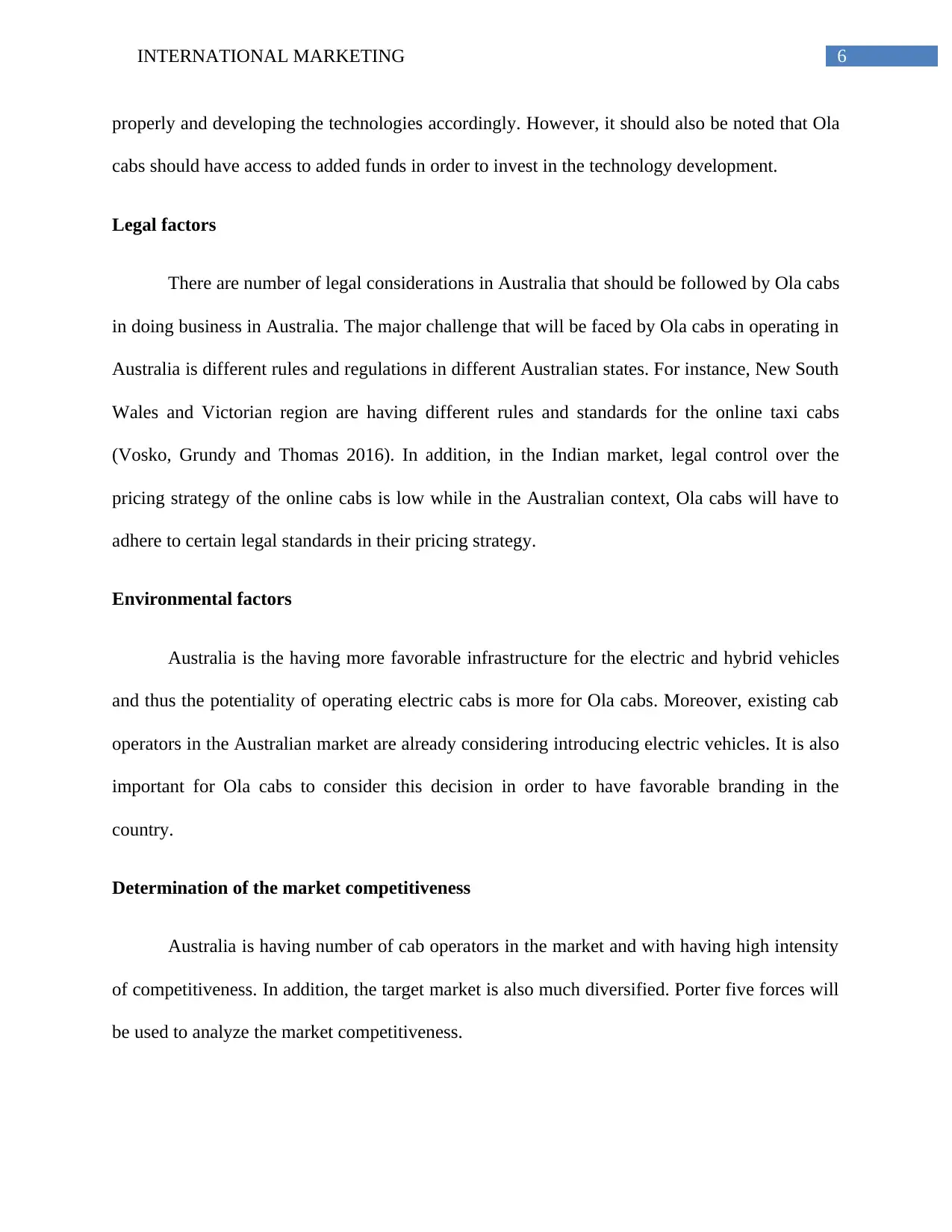
6INTERNATIONAL MARKETING
properly and developing the technologies accordingly. However, it should also be noted that Ola
cabs should have access to added funds in order to invest in the technology development.
Legal factors
There are number of legal considerations in Australia that should be followed by Ola cabs
in doing business in Australia. The major challenge that will be faced by Ola cabs in operating in
Australia is different rules and regulations in different Australian states. For instance, New South
Wales and Victorian region are having different rules and standards for the online taxi cabs
(Vosko, Grundy and Thomas 2016). In addition, in the Indian market, legal control over the
pricing strategy of the online cabs is low while in the Australian context, Ola cabs will have to
adhere to certain legal standards in their pricing strategy.
Environmental factors
Australia is the having more favorable infrastructure for the electric and hybrid vehicles
and thus the potentiality of operating electric cabs is more for Ola cabs. Moreover, existing cab
operators in the Australian market are already considering introducing electric vehicles. It is also
important for Ola cabs to consider this decision in order to have favorable branding in the
country.
Determination of the market competitiveness
Australia is having number of cab operators in the market and with having high intensity
of competitiveness. In addition, the target market is also much diversified. Porter five forces will
be used to analyze the market competitiveness.
properly and developing the technologies accordingly. However, it should also be noted that Ola
cabs should have access to added funds in order to invest in the technology development.
Legal factors
There are number of legal considerations in Australia that should be followed by Ola cabs
in doing business in Australia. The major challenge that will be faced by Ola cabs in operating in
Australia is different rules and regulations in different Australian states. For instance, New South
Wales and Victorian region are having different rules and standards for the online taxi cabs
(Vosko, Grundy and Thomas 2016). In addition, in the Indian market, legal control over the
pricing strategy of the online cabs is low while in the Australian context, Ola cabs will have to
adhere to certain legal standards in their pricing strategy.
Environmental factors
Australia is the having more favorable infrastructure for the electric and hybrid vehicles
and thus the potentiality of operating electric cabs is more for Ola cabs. Moreover, existing cab
operators in the Australian market are already considering introducing electric vehicles. It is also
important for Ola cabs to consider this decision in order to have favorable branding in the
country.
Determination of the market competitiveness
Australia is having number of cab operators in the market and with having high intensity
of competitiveness. In addition, the target market is also much diversified. Porter five forces will
be used to analyze the market competitiveness.
Paraphrase This Document
Need a fresh take? Get an instant paraphrase of this document with our AI Paraphraser
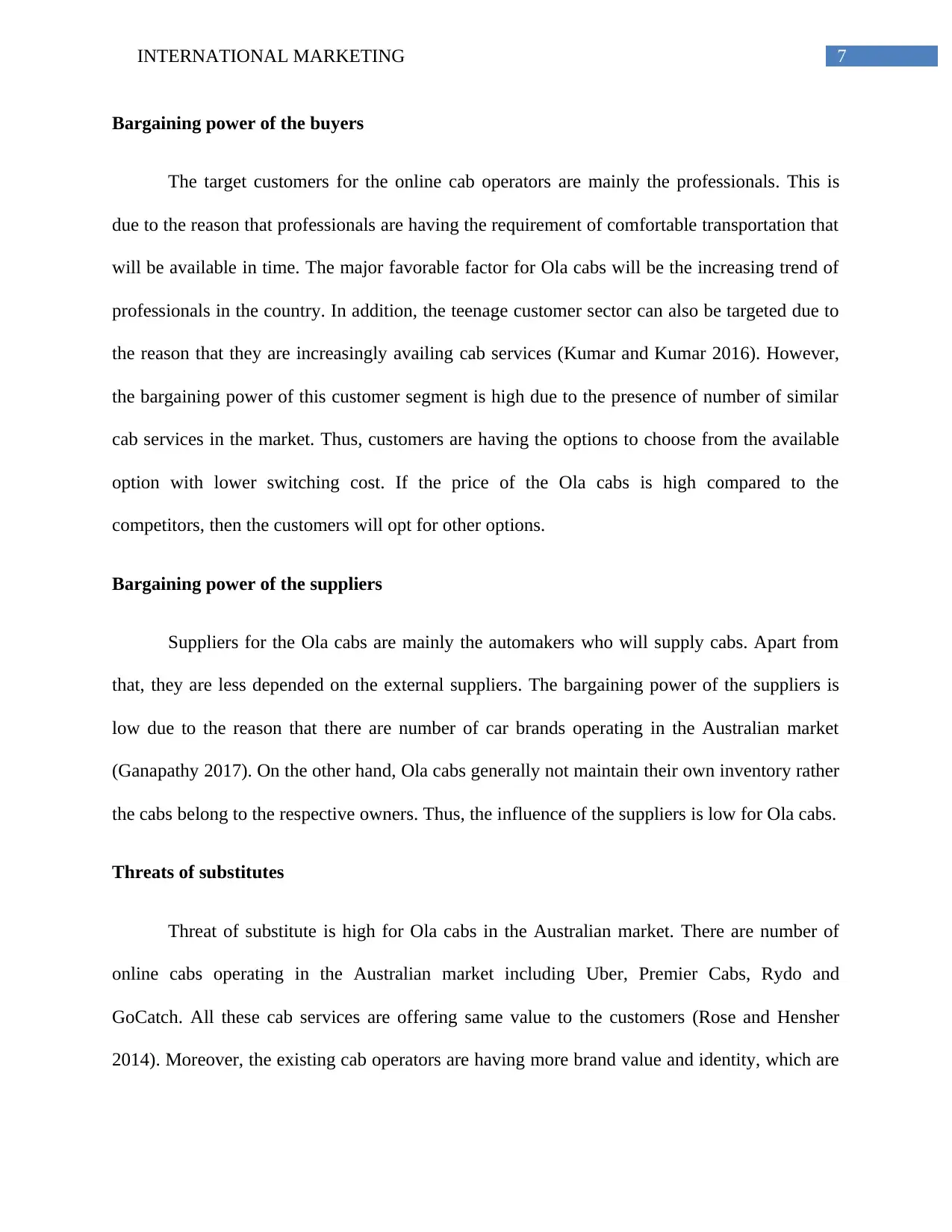
7INTERNATIONAL MARKETING
Bargaining power of the buyers
The target customers for the online cab operators are mainly the professionals. This is
due to the reason that professionals are having the requirement of comfortable transportation that
will be available in time. The major favorable factor for Ola cabs will be the increasing trend of
professionals in the country. In addition, the teenage customer sector can also be targeted due to
the reason that they are increasingly availing cab services (Kumar and Kumar 2016). However,
the bargaining power of this customer segment is high due to the presence of number of similar
cab services in the market. Thus, customers are having the options to choose from the available
option with lower switching cost. If the price of the Ola cabs is high compared to the
competitors, then the customers will opt for other options.
Bargaining power of the suppliers
Suppliers for the Ola cabs are mainly the automakers who will supply cabs. Apart from
that, they are less depended on the external suppliers. The bargaining power of the suppliers is
low due to the reason that there are number of car brands operating in the Australian market
(Ganapathy 2017). On the other hand, Ola cabs generally not maintain their own inventory rather
the cabs belong to the respective owners. Thus, the influence of the suppliers is low for Ola cabs.
Threats of substitutes
Threat of substitute is high for Ola cabs in the Australian market. There are number of
online cabs operating in the Australian market including Uber, Premier Cabs, Rydo and
GoCatch. All these cab services are offering same value to the customers (Rose and Hensher
2014). Moreover, the existing cab operators are having more brand value and identity, which are
Bargaining power of the buyers
The target customers for the online cab operators are mainly the professionals. This is
due to the reason that professionals are having the requirement of comfortable transportation that
will be available in time. The major favorable factor for Ola cabs will be the increasing trend of
professionals in the country. In addition, the teenage customer sector can also be targeted due to
the reason that they are increasingly availing cab services (Kumar and Kumar 2016). However,
the bargaining power of this customer segment is high due to the presence of number of similar
cab services in the market. Thus, customers are having the options to choose from the available
option with lower switching cost. If the price of the Ola cabs is high compared to the
competitors, then the customers will opt for other options.
Bargaining power of the suppliers
Suppliers for the Ola cabs are mainly the automakers who will supply cabs. Apart from
that, they are less depended on the external suppliers. The bargaining power of the suppliers is
low due to the reason that there are number of car brands operating in the Australian market
(Ganapathy 2017). On the other hand, Ola cabs generally not maintain their own inventory rather
the cabs belong to the respective owners. Thus, the influence of the suppliers is low for Ola cabs.
Threats of substitutes
Threat of substitute is high for Ola cabs in the Australian market. There are number of
online cabs operating in the Australian market including Uber, Premier Cabs, Rydo and
GoCatch. All these cab services are offering same value to the customers (Rose and Hensher
2014). Moreover, the existing cab operators are having more brand value and identity, which are
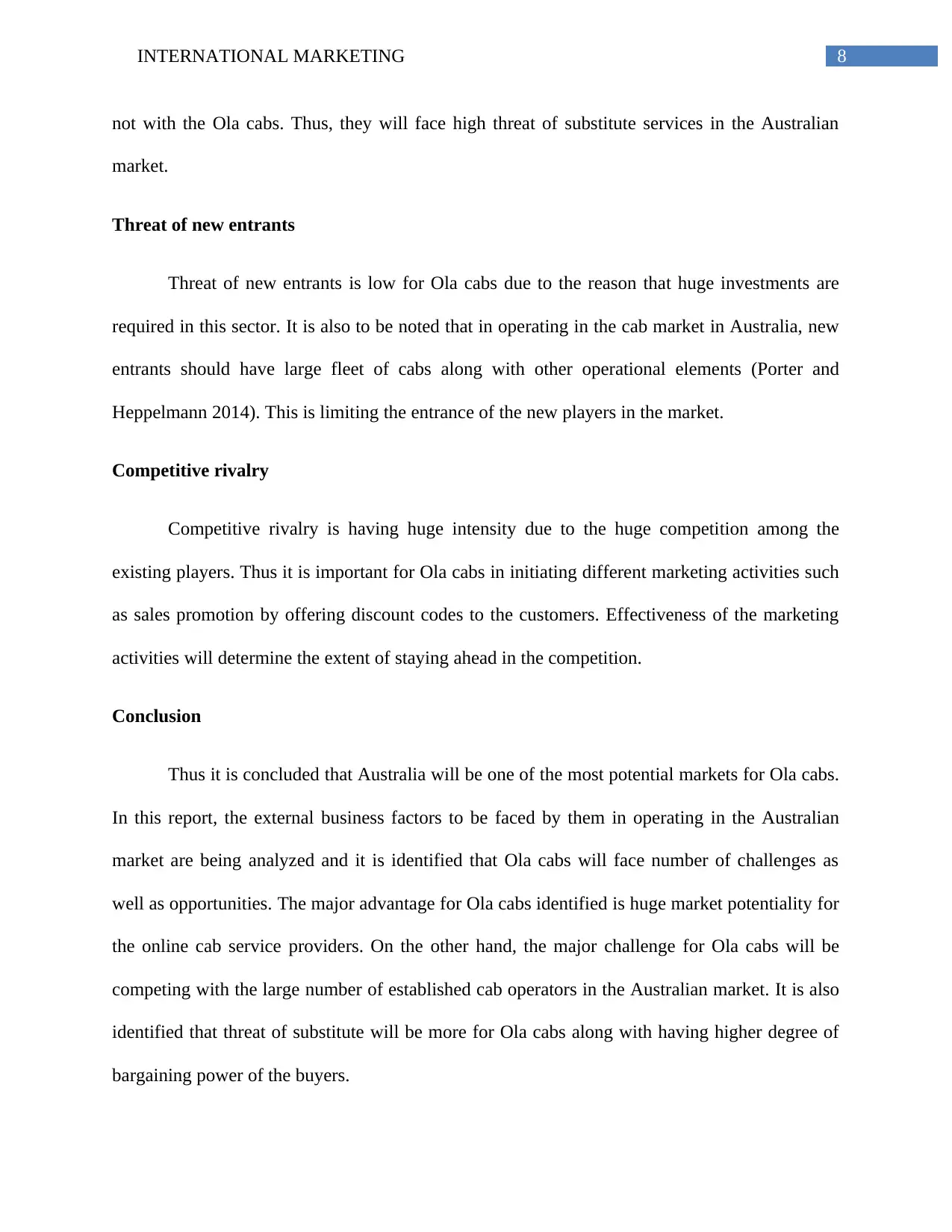
8INTERNATIONAL MARKETING
not with the Ola cabs. Thus, they will face high threat of substitute services in the Australian
market.
Threat of new entrants
Threat of new entrants is low for Ola cabs due to the reason that huge investments are
required in this sector. It is also to be noted that in operating in the cab market in Australia, new
entrants should have large fleet of cabs along with other operational elements (Porter and
Heppelmann 2014). This is limiting the entrance of the new players in the market.
Competitive rivalry
Competitive rivalry is having huge intensity due to the huge competition among the
existing players. Thus it is important for Ola cabs in initiating different marketing activities such
as sales promotion by offering discount codes to the customers. Effectiveness of the marketing
activities will determine the extent of staying ahead in the competition.
Conclusion
Thus it is concluded that Australia will be one of the most potential markets for Ola cabs.
In this report, the external business factors to be faced by them in operating in the Australian
market are being analyzed and it is identified that Ola cabs will face number of challenges as
well as opportunities. The major advantage for Ola cabs identified is huge market potentiality for
the online cab service providers. On the other hand, the major challenge for Ola cabs will be
competing with the large number of established cab operators in the Australian market. It is also
identified that threat of substitute will be more for Ola cabs along with having higher degree of
bargaining power of the buyers.
not with the Ola cabs. Thus, they will face high threat of substitute services in the Australian
market.
Threat of new entrants
Threat of new entrants is low for Ola cabs due to the reason that huge investments are
required in this sector. It is also to be noted that in operating in the cab market in Australia, new
entrants should have large fleet of cabs along with other operational elements (Porter and
Heppelmann 2014). This is limiting the entrance of the new players in the market.
Competitive rivalry
Competitive rivalry is having huge intensity due to the huge competition among the
existing players. Thus it is important for Ola cabs in initiating different marketing activities such
as sales promotion by offering discount codes to the customers. Effectiveness of the marketing
activities will determine the extent of staying ahead in the competition.
Conclusion
Thus it is concluded that Australia will be one of the most potential markets for Ola cabs.
In this report, the external business factors to be faced by them in operating in the Australian
market are being analyzed and it is identified that Ola cabs will face number of challenges as
well as opportunities. The major advantage for Ola cabs identified is huge market potentiality for
the online cab service providers. On the other hand, the major challenge for Ola cabs will be
competing with the large number of established cab operators in the Australian market. It is also
identified that threat of substitute will be more for Ola cabs along with having higher degree of
bargaining power of the buyers.
⊘ This is a preview!⊘
Do you want full access?
Subscribe today to unlock all pages.

Trusted by 1+ million students worldwide
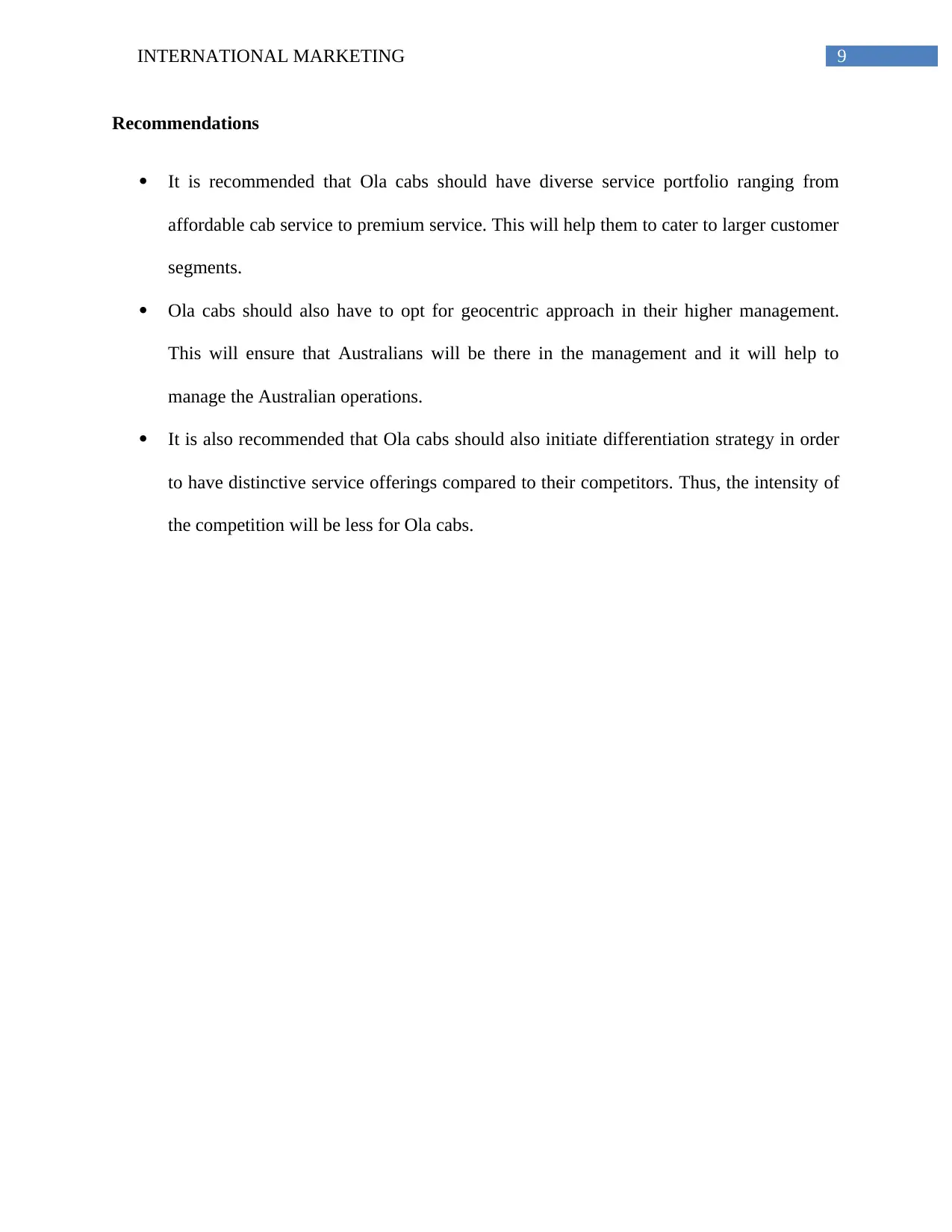
9INTERNATIONAL MARKETING
Recommendations
It is recommended that Ola cabs should have diverse service portfolio ranging from
affordable cab service to premium service. This will help them to cater to larger customer
segments.
Ola cabs should also have to opt for geocentric approach in their higher management.
This will ensure that Australians will be there in the management and it will help to
manage the Australian operations.
It is also recommended that Ola cabs should also initiate differentiation strategy in order
to have distinctive service offerings compared to their competitors. Thus, the intensity of
the competition will be less for Ola cabs.
Recommendations
It is recommended that Ola cabs should have diverse service portfolio ranging from
affordable cab service to premium service. This will help them to cater to larger customer
segments.
Ola cabs should also have to opt for geocentric approach in their higher management.
This will ensure that Australians will be there in the management and it will help to
manage the Australian operations.
It is also recommended that Ola cabs should also initiate differentiation strategy in order
to have distinctive service offerings compared to their competitors. Thus, the intensity of
the competition will be less for Ola cabs.
Paraphrase This Document
Need a fresh take? Get an instant paraphrase of this document with our AI Paraphraser
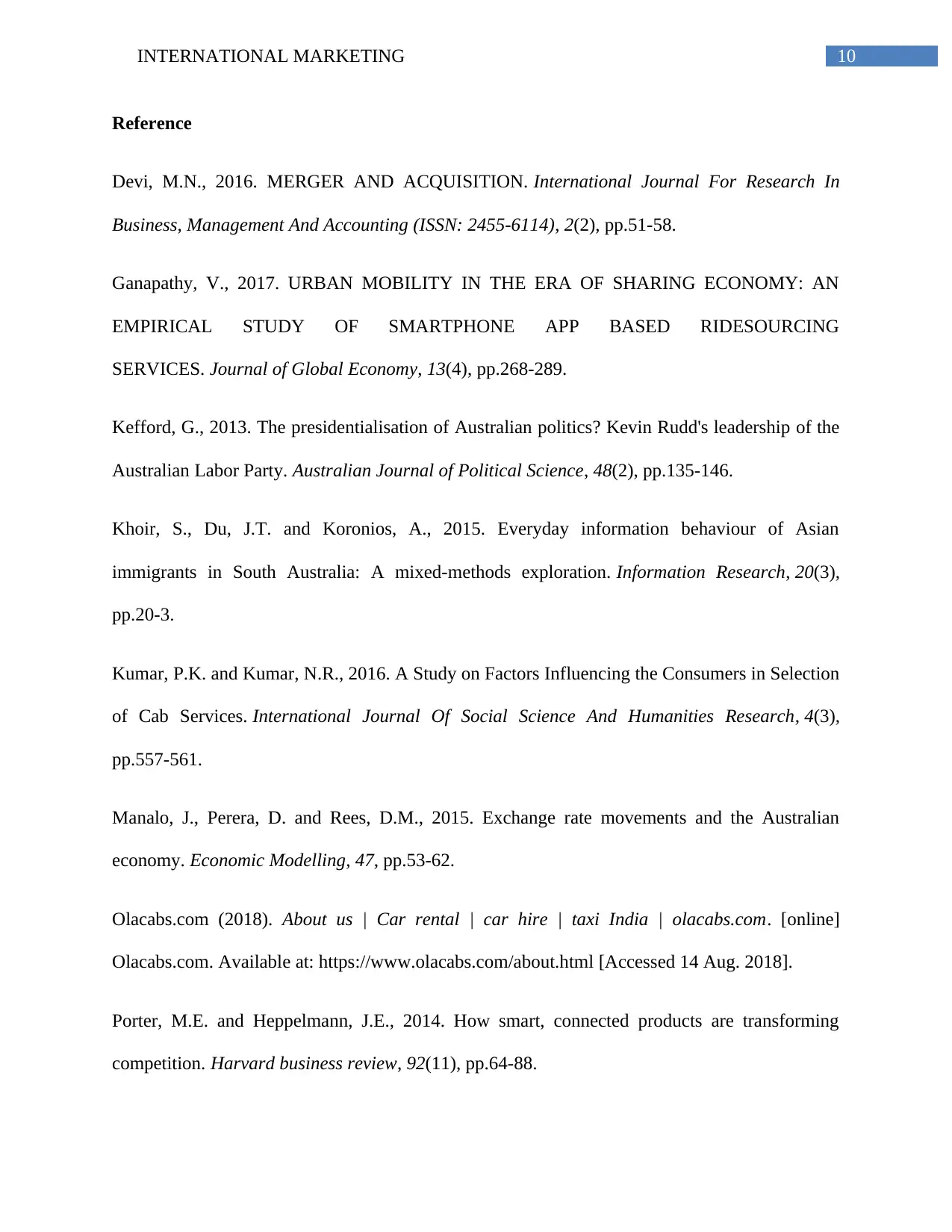
10INTERNATIONAL MARKETING
Reference
Devi, M.N., 2016. MERGER AND ACQUISITION. International Journal For Research In
Business, Management And Accounting (ISSN: 2455-6114), 2(2), pp.51-58.
Ganapathy, V., 2017. URBAN MOBILITY IN THE ERA OF SHARING ECONOMY: AN
EMPIRICAL STUDY OF SMARTPHONE APP BASED RIDESOURCING
SERVICES. Journal of Global Economy, 13(4), pp.268-289.
Kefford, G., 2013. The presidentialisation of Australian politics? Kevin Rudd's leadership of the
Australian Labor Party. Australian Journal of Political Science, 48(2), pp.135-146.
Khoir, S., Du, J.T. and Koronios, A., 2015. Everyday information behaviour of Asian
immigrants in South Australia: A mixed-methods exploration. Information Research, 20(3),
pp.20-3.
Kumar, P.K. and Kumar, N.R., 2016. A Study on Factors Influencing the Consumers in Selection
of Cab Services. International Journal Of Social Science And Humanities Research, 4(3),
pp.557-561.
Manalo, J., Perera, D. and Rees, D.M., 2015. Exchange rate movements and the Australian
economy. Economic Modelling, 47, pp.53-62.
Olacabs.com (2018). About us | Car rental | car hire | taxi India | olacabs.com. [online]
Olacabs.com. Available at: https://www.olacabs.com/about.html [Accessed 14 Aug. 2018].
Porter, M.E. and Heppelmann, J.E., 2014. How smart, connected products are transforming
competition. Harvard business review, 92(11), pp.64-88.
Reference
Devi, M.N., 2016. MERGER AND ACQUISITION. International Journal For Research In
Business, Management And Accounting (ISSN: 2455-6114), 2(2), pp.51-58.
Ganapathy, V., 2017. URBAN MOBILITY IN THE ERA OF SHARING ECONOMY: AN
EMPIRICAL STUDY OF SMARTPHONE APP BASED RIDESOURCING
SERVICES. Journal of Global Economy, 13(4), pp.268-289.
Kefford, G., 2013. The presidentialisation of Australian politics? Kevin Rudd's leadership of the
Australian Labor Party. Australian Journal of Political Science, 48(2), pp.135-146.
Khoir, S., Du, J.T. and Koronios, A., 2015. Everyday information behaviour of Asian
immigrants in South Australia: A mixed-methods exploration. Information Research, 20(3),
pp.20-3.
Kumar, P.K. and Kumar, N.R., 2016. A Study on Factors Influencing the Consumers in Selection
of Cab Services. International Journal Of Social Science And Humanities Research, 4(3),
pp.557-561.
Manalo, J., Perera, D. and Rees, D.M., 2015. Exchange rate movements and the Australian
economy. Economic Modelling, 47, pp.53-62.
Olacabs.com (2018). About us | Car rental | car hire | taxi India | olacabs.com. [online]
Olacabs.com. Available at: https://www.olacabs.com/about.html [Accessed 14 Aug. 2018].
Porter, M.E. and Heppelmann, J.E., 2014. How smart, connected products are transforming
competition. Harvard business review, 92(11), pp.64-88.
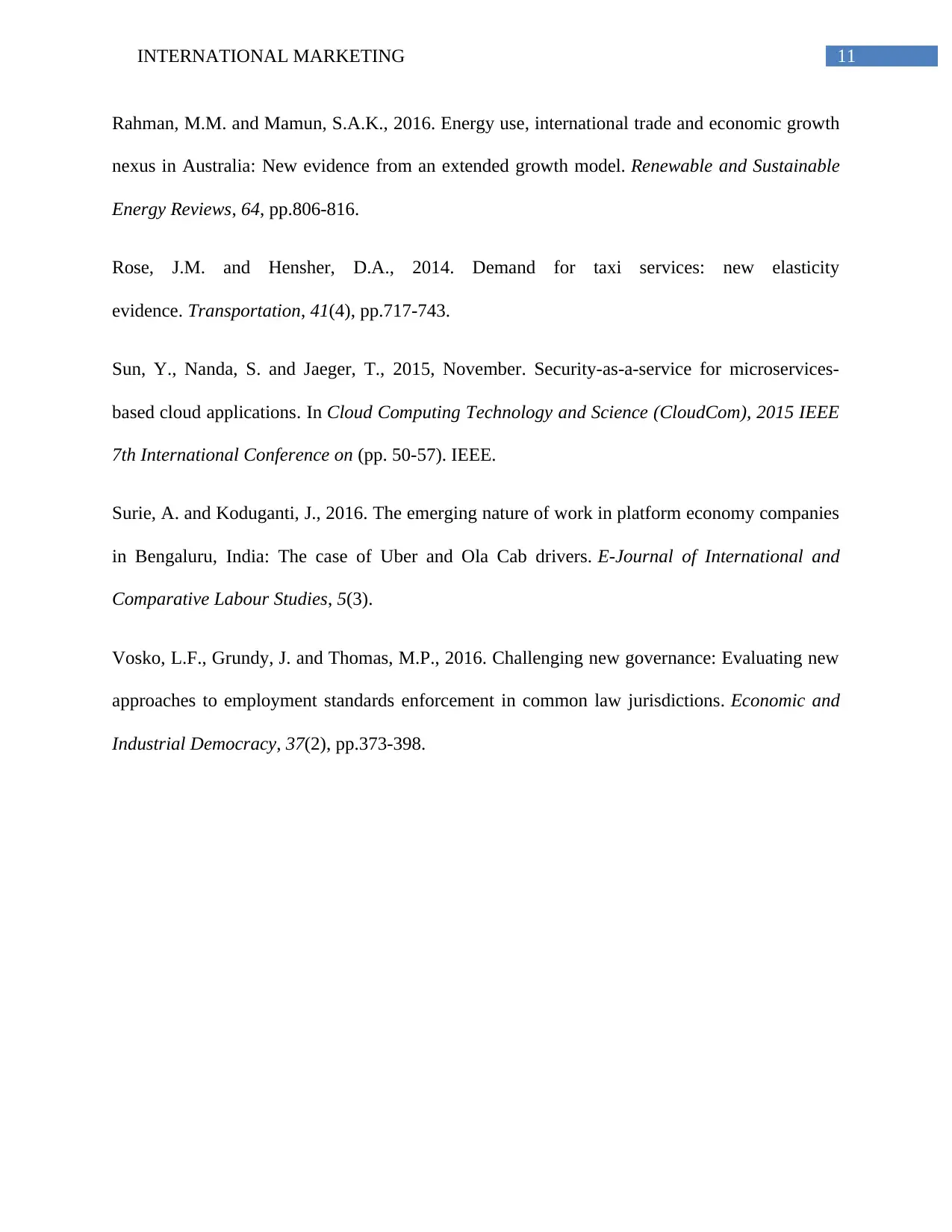
11INTERNATIONAL MARKETING
Rahman, M.M. and Mamun, S.A.K., 2016. Energy use, international trade and economic growth
nexus in Australia: New evidence from an extended growth model. Renewable and Sustainable
Energy Reviews, 64, pp.806-816.
Rose, J.M. and Hensher, D.A., 2014. Demand for taxi services: new elasticity
evidence. Transportation, 41(4), pp.717-743.
Sun, Y., Nanda, S. and Jaeger, T., 2015, November. Security-as-a-service for microservices-
based cloud applications. In Cloud Computing Technology and Science (CloudCom), 2015 IEEE
7th International Conference on (pp. 50-57). IEEE.
Surie, A. and Koduganti, J., 2016. The emerging nature of work in platform economy companies
in Bengaluru, India: The case of Uber and Ola Cab drivers. E-Journal of International and
Comparative Labour Studies, 5(3).
Vosko, L.F., Grundy, J. and Thomas, M.P., 2016. Challenging new governance: Evaluating new
approaches to employment standards enforcement in common law jurisdictions. Economic and
Industrial Democracy, 37(2), pp.373-398.
Rahman, M.M. and Mamun, S.A.K., 2016. Energy use, international trade and economic growth
nexus in Australia: New evidence from an extended growth model. Renewable and Sustainable
Energy Reviews, 64, pp.806-816.
Rose, J.M. and Hensher, D.A., 2014. Demand for taxi services: new elasticity
evidence. Transportation, 41(4), pp.717-743.
Sun, Y., Nanda, S. and Jaeger, T., 2015, November. Security-as-a-service for microservices-
based cloud applications. In Cloud Computing Technology and Science (CloudCom), 2015 IEEE
7th International Conference on (pp. 50-57). IEEE.
Surie, A. and Koduganti, J., 2016. The emerging nature of work in platform economy companies
in Bengaluru, India: The case of Uber and Ola Cab drivers. E-Journal of International and
Comparative Labour Studies, 5(3).
Vosko, L.F., Grundy, J. and Thomas, M.P., 2016. Challenging new governance: Evaluating new
approaches to employment standards enforcement in common law jurisdictions. Economic and
Industrial Democracy, 37(2), pp.373-398.
⊘ This is a preview!⊘
Do you want full access?
Subscribe today to unlock all pages.

Trusted by 1+ million students worldwide
1 out of 12
Related Documents
Your All-in-One AI-Powered Toolkit for Academic Success.
+13062052269
info@desklib.com
Available 24*7 on WhatsApp / Email
![[object Object]](/_next/static/media/star-bottom.7253800d.svg)
Unlock your academic potential
Copyright © 2020–2025 A2Z Services. All Rights Reserved. Developed and managed by ZUCOL.





